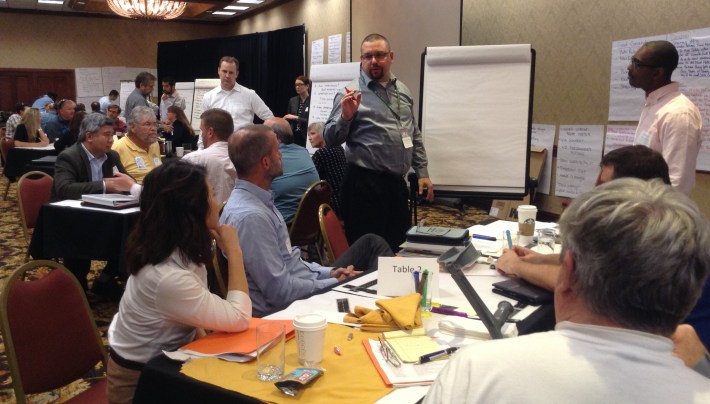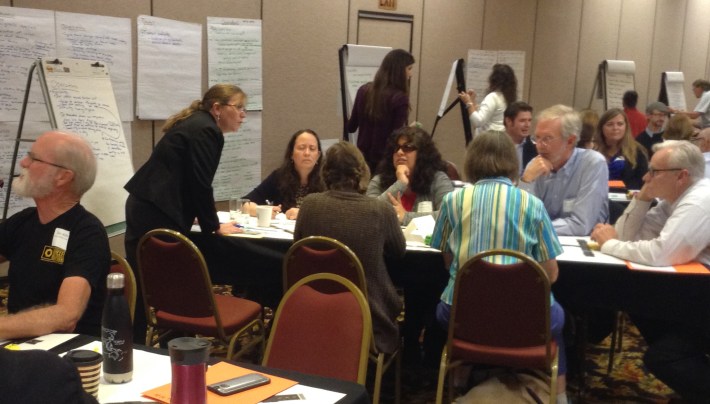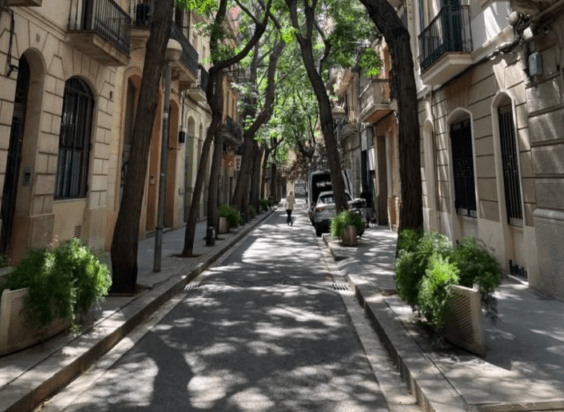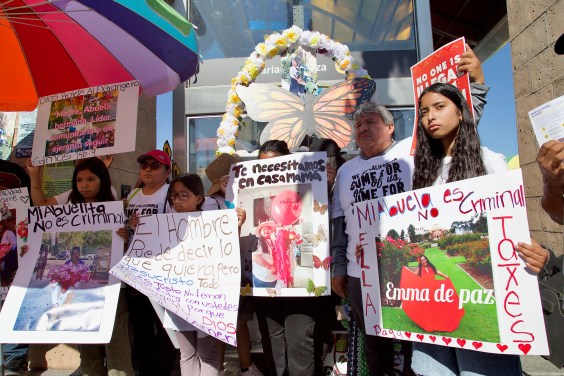Caltrans tried an experiment last week. Under a legislative deadline to create standards for Class IV Bikeways, also known as cycle tracks or protected bike lanes, the state department of transportation reached out to people who had expressed an interest in the subject and asked them for ideas.
Caltrans may have gotten more than it bargained for.
In a packed conference room in Sacramento last Wednesday, city planners, engineers, county employees, and advocates for bicycling, walking, and disabled access participated in a wide-ranging, open-ended discussion about what Caltrans needs to consider in writing up standards for protected lanes.
Last year, the state legislature passed a bill, A.B. 1193, that defined Class IV Bikeways-- also known as cycletracks or protected bike lanes--as a new kind of bicycle facility in the California vehicle code. The new law also required Caltrans to develop guidance for local jurisdictions to use when they design and build the new bikeways.
If Caltrans had merely complied with the law in its usual way, it would have first written guidance, made that available for public comment, and then revised the guidance accordingly.
But Caltrans Design Chief Timothy Craggs decided to try something different. He was concerned that his team could end up playing middleman among warring factions. They'd already heard from groups opposed to or concerned about protected bike lanes. Disability advocates, for example, have raised concerns about interactions between cyclists and pedestrians on protected lanes. Vehicular cyclists, following the John Forester philosophy that says bikes should mix in with other traffic, have long opposed building protected facilities for cyclists.
So Caltrans sent out a survey with the purpose of finding a wide range of people to bring together to discuss the pros and cons of protected bicycle lanes. Over nine hundred people responded, the majority of them expressing interest in attending. Caltrans then had to narrow that to a manageable number, while still finding a balance among attendees.
In some ways it succeeded: the crowd at last week's workshop was about evenly balanced among advocates, city and county employees, and state employees. Even among the bicycle advocates there was some balance, with representation from several bicycle coalitions as well as vehicular cyclists. Representatives from a couple of disability advocacy groups brought their perspectives to the table.
Still, it wasn't a perfectly diverse group. The vast majority of the people in the room were white. Southern California was not well represented, and men outnumbered women about two to one.
“Caltrans will be quiet today,” said Craggs. “We're here to listen.” The idea was to get participants to appreciate the various viewpoints represented, and to that end groups were continually mixed up throughout the day. Caltrans employees let the discussions go where they would, acting as notetakers and facilitators.
The workshop was set up to be very open-ended. Three broad topics were introduced—Design, Operations, and Implementation. Because they were so broad, the discussions tended to wander off to the concerns of participants, with subjects overlapping and themes repeated throughout the day. Craggs and the other facilitators didn't seem to mind this vagueness, since their purpose was to get participants to listen to each other. “Today is about sharing and listening,” he reminded everyone. “We are not looking for solutions yet.”
Nevertheless solutions were sought. One group immediately jumped into an involved discussion of the difference between standards and guidance, which turned out to be a topic throughout the day. Some participants insisted that strict standards are necessary to protect users. Others pointed out that without some flexibility planners might just drop a facility—the old disappearing bike lane trick—right when it's most needed, simply because standards are too strict and cannot be met. One participant said, “Bicyclists might avoid biking altogether because of one bad intersection.” An engineer pointed to an illustration in the recent FHWA guidance and said, “This is pretty good—it shows a range of widths that can be used. But engineers want specifics—we need to know what widths make sense in which circumstances.”
Flexibility is important as well for “trying out” new designs. People recommended that Caltrans come up with flexible guidelines for creating temporary, low-cost protected bike lanes that could be revised after testing the concept and teaching people how to use it. There were suggestions that Caltrans create a process to incorporate experimentation, and that the standards be allowed to evolve over time.
Flexibility may even turn out to be more important as time goes by. “If you are successful in tripling bicycling,” said Jim Baross of CABO, referring to Caltrans' recent strategic planning goal, “a five-foot lane will very soon be inadequate to future needs.”
Education—of car drivers, pedestrians, and bicycle riders— about how to work with protected bike lanes was another recurring theme. Signs, sign placement, and signals are key, said several people; at the same time, the design needs to be intuitive and easily understood. Pavement treatments are needed that can signal to blind people that they are approaching a protected bike lane.
At first this workshop seemed determined to reinvent the wheel, instead of just adopting already existing guides like the NACTO Urban Bikeway Design Guide or the recent FHWA Separated Bike Lane Planning and Design Guide. But one thing was clear after several hours of eavesdropping on conversations: there is a lot of interest in the details of designing protected bike lanes so they work for everyone.
Issues discussed included: sight lines; intersection design; coexisting with parked cars and loading zones as well as accessible vehicles and ramps; whether there should be a standard color for the lanes; how to keep in mind that bicycle riders value momentum and therefore stops should be kept to a minimum; the role of aesthetics in attracting riders to use the facilities; and looking at the system as a network.
Several people, among them Dave Campbell of Bike East Bay, pointed out that this is an opportunity for California to lead the world. “There's no reason to assume that the Dutch CROW Manual is the best possible guidance,” he said. “We could make the choice to be the best. We could have the Dutch and the Danish calling us for advice.”
Caltrans seemed pleased with the results of its experiment. “The workshop provided a great opportunity for the numerous stakeholders to have their voices heard by all, not just Caltrans,” said Craggs. “The greatest outcome for me was the recognition by attendees that Caltrans has a challenge facing us in developing a well-balanced set of guidelines for Class IV bikeways." That's a challenge that Caltrans is "prepared to meet," he said, "in partnership with our stakeholders.”
For now Caltrans must synthesize the feedback it received, and make it available to the public. A plan for the next steps has not been formalized yet. However, Caltrans does have to meet a January 2016 deadline for producing some type of standard or guidance, even if it is preliminary. Therefore, look for draft guidelines some time before then.








